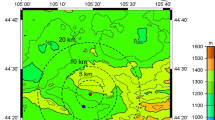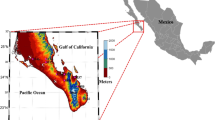Abstract
Precipitation causes several short- and long-term effects on wind-induced surface erodibility and subsequent dust emission. Among the principal effects considered by this paper are soil moisture, soil crusts, and vegetation. A quantitative method is developed to assess these effects using differences between the potential and the actual amounts of dust emitted from dust sources as inferred from surface meteorological measurements obtained downwind from those sources. The results of this assessment must be interpreted with caution, however, when the size and location of dust sources are unknown.
Using meteorological data recorded near Yuma, Arizona at the Yuma Marine Corps Air Station (YMCAS), the method is applied to calculate the potential and actual amounts of dust emitted from upwind dust sources during the spring and fall/winter seasons between January 1, 1981 and May 31, 1988. (Spring is considered to be the period between February 1 and May 31; fall/winter, between October 1 and January 31.) Because summer precipitation is intermittent and wind patterns are localized, summer meteorological data are not used to evaluate regional correlations between precipitation and dust storms. For the period between 1981 and 1988, a correlation of -0.60 was found between fall/winter precipitation and the actual amount of dust emitted from sources upwind of YMCAS during the following spring. A particularly strong reduction in dust emission was noted during the springs of 1983 and 1984 following the start of an ‘El Nino event’ in fall/winter 1982. Photographs taken at a geological and meteorological data-collection (Geomet) site, located in the natural desert 25 km southeast of YMCAS, show a correspondence between increased antecedent precipitation recorded at the site and increased vegetation. Whereas the annual precipitation totals at YMCAS and the Geomet site from the beginning of 1982 through 1984 are high, their seasonal totals, especially during the fall/winter seasons, are disparate. This fall/winter precipitation disparity may account for evidence suggesting that significant vegetation growth occurred at dust sources upwind of YMCAS by spring 1983, but that such growth did not occur at the Geomet site until fall/ winter of 1983. Spatial inhomogeneity in fall/winter precipitation probably contributed to the relatively low correlation (-0.60) between fall/winter precipitation recorded at YMCAS and the actual amount of dust emitted from upwind sources during the following spring.
Similar content being viewed by others
References
Andrade, E. R. and Sellers, W. D.: 1988, ‘El Niño and its Effect on Precipitation in Arizona and Western New Mexico’, J. Climat. 8, 403–410.
Barad, M. L. and Haugen, D. A. (eds.): 1958, Project Prairie Grass, a Field Program in Diffusion, Vols. I–III, Geophysical Research Papers No. 59, U.S. Air Force Cambridge Research Center, Bedford, Mass.
Bowers, M. A.: 1987, ‘Precipitation and the Relative Abundances of Desert Winter Annuals: A 6-Year Study in the Northern Mohave Desert’, J. Arid Envir. 12, 141–149.
Brazel, A. J. and Nickling, W. G.: 1986, ‘The Relationship of Weather Types to Duststorm Generation in Arizona (1965–1980)’, J. Climat. 6, 255–275.
Brazel, A. J. and Nickling, W. G.: 1987, ‘Dust Storms and Their Relation to Moisture in the Sonoran-Mojave Desert Region of the South-Western United States’, J. Env. Manage. 24, 279–291.
Brazel, A. J., Nickling, W. G., and Lee, J.: 1986, ‘Effect of Antecedent Moisture Conditions on Duststorm Generation in Arizona’, in Nickling, W. G. (ed.), Aeolian Geomorphology, Allen & Unwin Press, pp. 261–271.
Breed, C. S. and McCauley, J. F.: 1986, ‘Use of Duststorm Observations on Satellite Images to Identify Areas Vulnerable to Severe Wind Erosion’, Climatic Change 9, 243–258.
Breed, C. S., Musick, H. B., and Helm, P. J.: 1987, ‘Effects of Eolian Processes on Surface Properties of Semiarid Lands’, Executive Summaries, NASA, Interdisciplinary Science Land Surface Climatology, X-624-881, 53–59.
Changery, M. J.: 1983, A Dust Climatology of the Western United States, NUREG/CR-3211, Office of Nuclear Regulatory Research, Washington, D.C.
Committee on Conservation Needs and Opportunities: 1986, Soil Conservation, Assessing the National Resources Inventory, National Academy of Sciences, National Academy Press, Washington, D.C., 114 pp.
Crosswhite, F. S. and Crosswhite, C. D.: 1982, ‘The Sonoran Desert’, in Bender, G. L. (ed.), Reference Handbook on the Deserts of North America, Greenwood Press, Westport, Conn.
Ezcurra, E. and Rodrigues, V.: 1986, ‘Rainfall Patterns in the Gran Desierto, Sonora, Mexico, J. Arid Envir. 10, 13–28.
Felger, R. S.: 1980, ‘Vegetation and Flora of the Gran Desierto, Sonora, Mexico’, Desert Plants 2, 87–114.
Gillette, D. A.: 1981, ‘Production of Dust that May be Carried Great Distances’, in Péwé, T. L. (ed.), Desert Dust: Origin, Characteristics, and Effect on Man, Geol. Soc. Amer., Special Paper 186, pp. 11–26.
Gillette, D. A.: 1986, ‘Production of Dust’, in El-Baz, Farouk and Hassan, M. H. A. (eds.), Physics of Desertification, Martinus Nijhoff Publ., The Netherlands, 473 pp.
Gillette, D. A.: 1988, ‘Threshold Friction Velocities for Dust Production for Agricultural Soils’, J. Geophys. Res. 93, 12, 645–12,662.
Gillette, D. A. and Passi, R.: 1988, ‘Modeling Dust Emission Caused by Wind Erosion’, J. Geophys. Res. 93, 14, 233–14,242.
Johnson, J. C.: 1954, Physical Meteorology, The M.I.T. Press, Cambridge, Mass. 393 pp.
Lougeay, R., Brazel, A. J., and Miller, T. A.: 1987, ‘Monitoring Changing Desert Biomass through Video Digitization of Landsat MSS Data: An Application to Dust Storm Generation’, J. Photogramm. Eng. and Rem. Sens. 53, 1251–1254.
McCauley, J. F., Breed, C. S., Grolier, M. J., and MacKinnon, D. J.: 1981, ‘The U.S. Dust Storm of February 1977’, Geological Society of America Special Paper 186, 123–147.
McCauley, J. F., Breed, C. S., Helm, P. J., Billingsley, G. H., MacKinnon, D. J., Grolier, M. J., and McCauley, C. K.: 1984, ‘Remote Monitoring of Processes that Shape Desert Surfaces: The Desert Winds Project’, U.S. Geological Survey Bull. 1634, 1–19.
Nickling, W. G.: 1988, ‘The Initiation of Particle Movement by Wind’, Sedimentology 35, 499–511.
Nickling, W. G. and Brazel, A. J.: 1984, ‘Temporal and Spatial Characteristics of Arizona Dust Storms (1965–1980), J. Climat. 4, 645–660.
Norris, R. M. and Norris, K. S.: 1961, ‘Algodones Dunes of Southeastern California’, Geol. Soc. Amer. Bull. 72, 605–620.
Orgill, M. M. and Sehmel, G. A.: 1976, ‘Frequency and Diurnal Variation Duststorms in the Contiguous U.S.A.’, Atmos. Envir. 10, 310.
Olmsted, F. H., Loeltz, O. J., and Irelan, B.: 1973, ‘Geohydrology of the Yuma Area, Arizona and California’, U.S. Geological Survey Professional Paper 486-H, 227 pp.
Phillips, A. M. III: 1984, ‘Spring Wildflowers of the Desert’, Plateau 55, 2–7.
Quinn, W. H., Neal, V. T., and Antunez de Mayolo, S. E.: 1987, ‘El Niño Occurrences over the Past Four and a Half Centuries’, J. Geophys. Res. 92, 14, 449–14,461.
Rowlands, P. S., Johnson, H., Ritter, E., and Endo, A.: 1982, ‘The Mojave Desert’, in Bender, G. L. (ed.), Reference Handbook on the Deserts of North America, Greenwood Press, Westport, Conn., 594 pp.
Sellers, W. D.: 1965, Physical Climatology, University of Chicago Press, Chicago, 272 pp.
Sellers, W. D. and Hill, R. H.: 1974, Arizona Climate 1931–1972, University of Arizona Press, Tucson, 616 pp.
Shreve, F. and Wiggins, I. L.: 1964, Vegetation and Flora of the Sonoran Desert, vol. 1, Stanford University Press, Stanford, Calif.
Turner, R. M. and Brown, D. E.: 1982, ‘Sonoran Desertsclub’; Desert Plants 4, 181–200.
Author information
Authors and Affiliations
Rights and permissions
About this article
Cite this article
Mackinnon, D.J., Elder, D.F., Helm, P.J. et al. A method of evaluating effects of antecedent precipitation on duststorms and its application to Yuma, Arizona, 1981–1988. Climatic Change 17, 331–360 (1990). https://doi.org/10.1007/BF00138374
Received:
Revised:
Issue Date:
DOI: https://doi.org/10.1007/BF00138374




